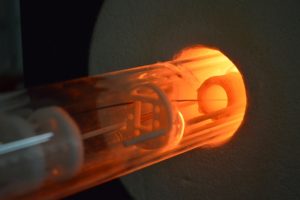Materials Research

In a laboratory furnace at 1050 °C for more than 100 hours, a glowing stainless steel sample is subjected to the same atmosphere in a quartz glass tube as is created during the combustion of natural gas. Photo: OWI
Metallic components in industrial furnaces, space heaters and mobile heating systems are exposed to high thermal loads that can lead to corrosion and deformation. The insulation of thermo-processing plants is also exposed to high loads of, for instance, eroding flows and chemical processes. Cost-intensive maintenance and downtimes are the consequences. Specific alloys are used for the component construction in order to lengthen maintenance cycles and to delay frequent replacement of components. But which materials are most appropriate for the components? By means of which experiment can the suitability be determined? How can material resistance be predicted and how can maintenance intervals be lengthened?
In various research projects at OWI, the corrosion resistance of metallic materials and coatings are investigated in burners, reformers and other systems under operating conditions and in laboratory furnaces under simulated conditions.
The laboratory furnaces at OWI are able to reach temperatures of up to 1200 °C and operate in various atmospheres. It is possible to change these atmospheres continually during the experiments. Different temperature profiles and high heating and cooling rates are possible and serve to investigate the thermal shock resistance and the adhesion properties of naturally growing oxide layers or coatings. In cooperation with other institutes materials analysis is carried out, such as light microscopy, scanning electron microscopy, electron beam microprobe analysis, X-ray diffraction and glow discharge optical emission spectroscopy. In various completed research projects, knowledge about the oxidation resistance of iron- and nickel-based high-temperature alloys has been acquired.
One aim of the materials research at OWI is the development of methods for the evaluation of the durability of components in high-temperature application (projects HT Life plus and Flexible furnace operation). Suitable models for the high-temperature corrosion and creep as well as experimental data of time-dependent properties of the materials are necessary. By means of these methods, the expected deformation and the oxidation resistance are predicted depending on the dimension of the component, operating temperature and the temporal thermal load.
